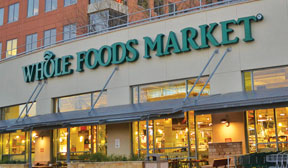 Factors ranging from food safety to the growth of boomers have made the opportunity for fresh, healthy foods “broad,” “wide,” “deep” and “growing,” Walter Robb, co-chief executive officer of Whole Foods Market, told participants at the Deutsche Bank dbAccess Consumer, Retail, Gaming and Lodging Conference held March 5 in Miami.
Factors ranging from food safety to the growth of boomers have made the opportunity for fresh, healthy foods “broad,” “wide,” “deep” and “growing,” Walter Robb, co-chief executive officer of Whole Foods Market, told participants at the Deutsche Bank dbAccess Consumer, Retail, Gaming and Lodging Conference held March 5 in Miami.With more than 340 stores in three countries and annual sales of more than $12 billion, Austin, Texas-based Whole Foods has established itself as a go-to outlet for consumers looking for food perceived as fresh and healthy.
Mr. Robb pointed to a number of factors — obesity in the United States and the cost associated with health care, food safety concerns, the growth of boomers and rise in the millennials — as reasons consumers are taking more responsibility for their diets.
“What we’ve seen over the last three years is that people adjust,” Mr. Robb said. “Once they know what it is, they adjust, and they make their choices, and that’s why I say that I think the desire for fresh, healthy foods and a desire for a healthier lifestyle — it’s here to stay.”
Mr. Robb said Whole Foods wants to be perceived as “the leader” in providing healthy foods, and believes the company has positioned itself as such, going so far as to say Whole Foods has the highest quality standards in the supermarket industry “and it’s not even close.”
“I think people perceive us as leaders, people are setting the bar on quality, their experience of coming in the store is different than just going to the supermarket,” he said. “Those are the things. And I want them to experience our folks as part of that. I mean, the experience of talking with the team members and fresh, healthy foods, excited team members, differentiated sort of shopping experience — those sorts of things, I think, set us apart.”
The price value, value quality conversation is a battle that Whole Foods is “always going to fight” because “it’s worth different things to different people,” Mr. Robb explained. For example, he said many consumers do not even want to have a conversation about why a grass fed New York steak may cost $14 a lb at Whole Foods but $9 a lb somewhere else.
Another opportunity for Whole Foods to deliver on the “value” message while educating consumers has come in the wake of Europe’s horse meat scandal, Mr. Robb said.
“It really is an opportunity,” he said. “Things like the horse meat thing that just happened … is another example if you’re not watching you don’t know what could be happening, right? So I mean there’s more of that stuff out there that’s going to come out — hamburger from seven different countries — there’s stuff like this across the food supply, and not that I want it to happen or anybody to get sick, but I’m telling you, as you look into this thing, more of this stuff is going to surface.
“It’s going to be about accountability and transparency, and that’s where our standards, I think, set us in a good place in terms of the evolving marketplace.
“We have a big opportunity to continue to communicate and educate. Not everybody — we’re not all things to all people. We’re not serving all of the marketplace, we recognize that. But then at the same time, our customers are continuing to broaden, our appeal is continuing to broaden, and we know that because we know — have information now that we’re across generations with our customers, and that’s a really good tailwind for Whole Foods, because I think Whole Foods has become now into a generation of people who grew up on it, 32 years old, and that’s something that moves beyond the wealth demographic and moves to an education demographic and moves to a values demographic that’s been very helpful to Whole Foods.”





